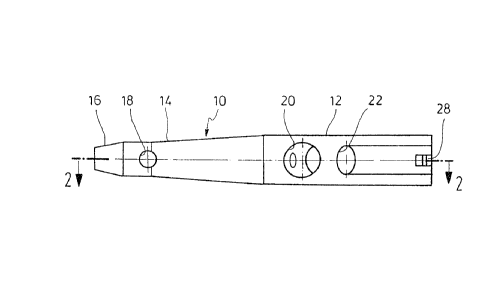Some of the information on this Web page has been provided by external sources. The Government of Canada is not responsible for the accuracy, reliability or currency of the information supplied by external sources. Users wishing to rely upon this information should consult directly with the source of the information. Content provided by external sources is not subject to official languages, privacy and accessibility requirements.
Any discrepancies in the text and image of the Claims and Abstract are due to differing posting times. Text of the Claims and Abstract are posted:
| (12) Patent: | (11) CA 2085539 |
|---|---|
| (54) English Title: | LOCKING NAIL FOR TREATING FRACTURES OF THE PROXIMAL FEMUR |
| (54) French Title: | CLOU DE BLOCAGE POUR LE TRAITEMENT DES FRACTURES DU FEMUR PROXIMAL |
| Status: | Expired |
| (51) International Patent Classification (IPC): |
|
|---|---|
| (72) Inventors : |
|
| (73) Owners : |
|
| (71) Applicants : | |
| (74) Agent: | SMART & BIGGAR |
| (74) Associate agent: | |
| (45) Issued: | 1998-07-28 |
| (22) Filed Date: | 1992-12-16 |
| (41) Open to Public Inspection: | 1993-07-15 |
| Examination requested: | 1993-02-10 |
| Availability of licence: | N/A |
| (25) Language of filing: | English |
| Patent Cooperation Treaty (PCT): | No |
|---|
| (30) Application Priority Data: | ||||||
|---|---|---|---|---|---|---|
|
A locking nail for treating fractures of the proximal femur, in
particular of subcapital fractures, comprising a nail shaft
including a cross-bore for receiving a bone screw in its distal
end portion and a pair of inclined bores for receiving femur neck
screws in its proximal portion, whereby the proximally located
angular bore has a larger diameter than the associated femur neck
screw.
L'invention porte sur un clou de blocage pour traiter les fractures du fémur proximal, plus particulièrement les fractures sous-capitales. Le clou est formé d'une tige comprenant un alésage transversal, pour recevoir une vis pour os à l'extrémité distale, et une paire d'alésages inclinés, pour recevoir des vis pour col du fémur dans la partie proximale. L'alésage angulaire se trouvant dans la partie proximale présente un diamètre plus grand que celui de la vis pour col du fémur associée.
Note: Claims are shown in the official language in which they were submitted.
Note: Descriptions are shown in the official language in which they were submitted.

For a clearer understanding of the status of the application/patent presented on this page, the site Disclaimer , as well as the definitions for Patent , Administrative Status , Maintenance Fee and Payment History should be consulted.
| Title | Date |
|---|---|
| Forecasted Issue Date | 1998-07-28 |
| (22) Filed | 1992-12-16 |
| Examination Requested | 1993-02-10 |
| (41) Open to Public Inspection | 1993-07-15 |
| (45) Issued | 1998-07-28 |
| Expired | 2012-12-17 |
There is no abandonment history.
| Fee Type | Anniversary Year | Due Date | Amount Paid | Paid Date |
|---|---|---|---|---|
| Application Fee | $0.00 | 1992-12-16 | ||
| Registration of a document - section 124 | $0.00 | 1993-06-22 | ||
| Maintenance Fee - Application - New Act | 2 | 1994-12-16 | $100.00 | 1994-09-07 |
| Maintenance Fee - Application - New Act | 3 | 1995-12-18 | $100.00 | 1995-09-11 |
| Maintenance Fee - Application - New Act | 4 | 1996-12-16 | $100.00 | 1996-12-06 |
| Maintenance Fee - Application - New Act | 5 | 1997-12-16 | $150.00 | 1997-09-08 |
| Final Fee | $300.00 | 1998-03-26 | ||
| Maintenance Fee - Patent - New Act | 6 | 1998-12-16 | $150.00 | 1998-12-10 |
| Maintenance Fee - Patent - New Act | 7 | 1999-12-16 | $150.00 | 1999-11-04 |
| Maintenance Fee - Patent - New Act | 8 | 2000-12-18 | $150.00 | 2000-11-03 |
| Registration of a document - section 124 | $100.00 | 2000-12-18 | ||
| Maintenance Fee - Patent - New Act | 9 | 2001-12-17 | $150.00 | 2001-10-17 |
| Maintenance Fee - Patent - New Act | 10 | 2002-12-16 | $200.00 | 2002-11-05 |
| Maintenance Fee - Patent - New Act | 11 | 2003-12-16 | $200.00 | 2003-10-08 |
| Maintenance Fee - Patent - New Act | 12 | 2004-12-16 | $250.00 | 2004-10-15 |
| Maintenance Fee - Patent - New Act | 13 | 2005-12-16 | $250.00 | 2005-08-12 |
| Maintenance Fee - Patent - New Act | 14 | 2006-12-18 | $450.00 | 2007-04-03 |
| Maintenance Fee - Patent - New Act | 15 | 2007-12-17 | $450.00 | 2007-10-19 |
| Maintenance Fee - Patent - New Act | 16 | 2008-12-16 | $450.00 | 2008-10-23 |
| Maintenance Fee - Patent - New Act | 17 | 2009-12-16 | $450.00 | 2009-10-29 |
| Maintenance Fee - Patent - New Act | 18 | 2010-12-16 | $450.00 | 2010-10-18 |
| Maintenance Fee - Patent - New Act | 19 | 2011-12-16 | $450.00 | 2011-10-27 |
Note: Records showing the ownership history in alphabetical order.
| Current Owners on Record |
|---|
| STRYKER TRAUMA GMBH |
| Past Owners on Record |
|---|
| GROSSE, ARSENE JEROME |
| HARDER, HANS ERICH |
| HOWMEDICA GMBH |